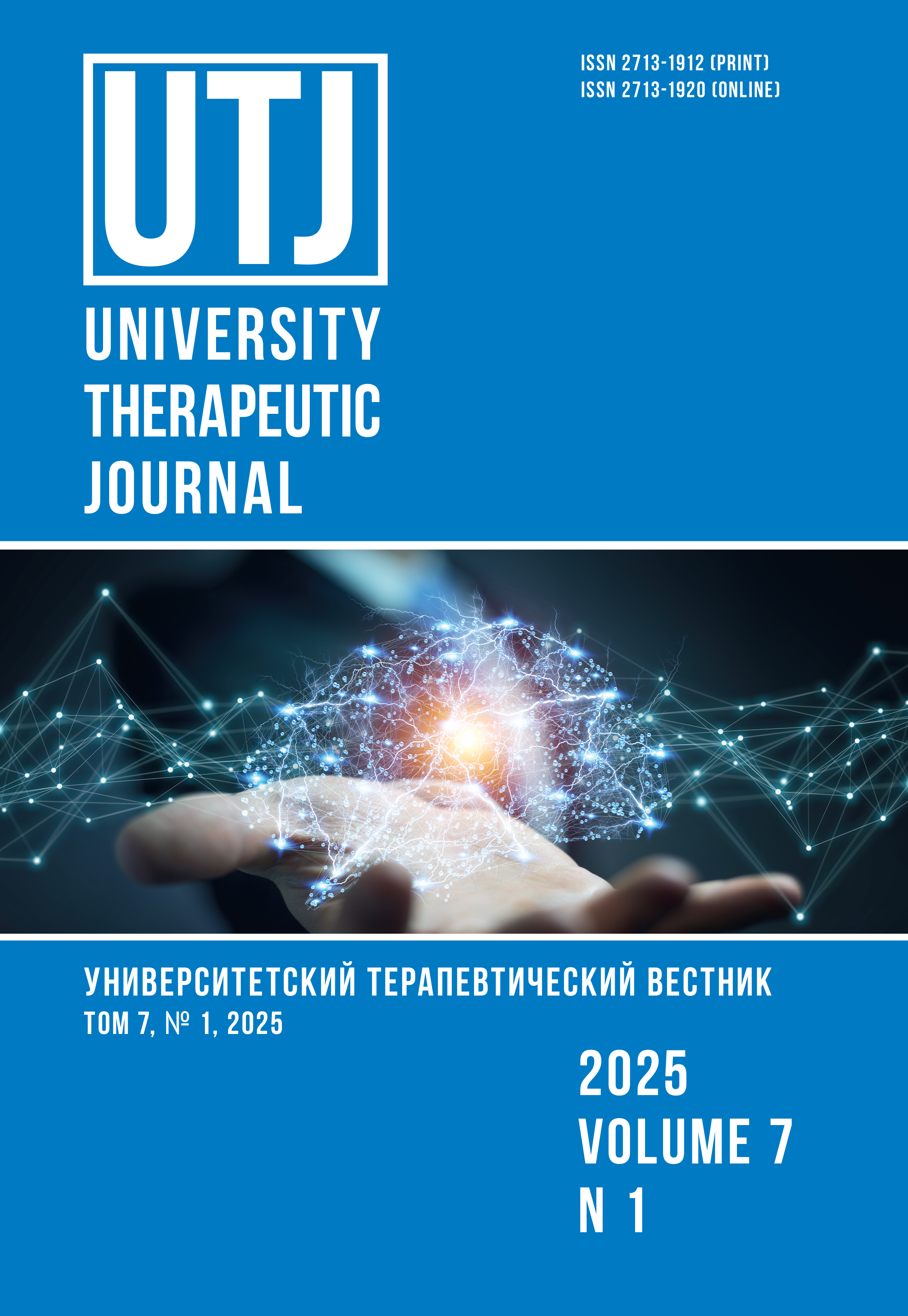A CLINICAL CASE OF DRUG-INDUCED LIVER DAMAGE
Abstract
Drug-induced liver injury (DILI) is an adverse reaction to drugs or other xenobiotics that occurs either as a predictable event when an individual is exposed to various toxic doses of certain compounds or as an unpredictable event during the routine use of various drugs. Almost all cases of LPP encountered in clinical practice are idiosyncratic in nature. Recently, cases of indiscriminate intake of medicines and biologically active supplements (BAA) without a doctor’s prescription have become more frequent. Due to incomplete collection of anamnesis, underestimation of the data of toxic effect of drugs and dietary supplements, the diagnosis of drug-induced liver damage is established late and disguised under the mask of unverified hepatitis. The appearance on the market of a large number of dietary supplements and their unjustified intake by people make the problem of drug-induced liver damage even more urgent. This paper presents a clinical case of drug-induced liver damage with manifestations in the form of parenchymatous jaundice against the background of taking Neem (Azadirachta indica) dietary supplement in a 49-year-old female patient. The authors of the article draw the readers’ attention to the importance of more detailed and in-depth pharmacological collection of anamnesis in patients with increased activity of transaminase level, manifestations in the form of jaundice in accordance with the existing trend of active promotion of dietary supplements among the population.
References
Ивашкин В.Т., Барановский А.Ю., Райхельсон К.Л., Пальгова Л.К., Маевская М.В., Кондрашина Э.А., Марченко Н.В., Некрасова Т.П., Никитин И.Г. Лекарственные поражения печени (клинические рекомендации для врачей). Российский журнал гастроэнтерологии, гепатологии, колопроктологии. 2019;29(1):101–131. DOI: 10.22416/1382-4376-2019-29-1-101-131.
Мельдеханов Т.Т., Куттыбаев А.Д., Иманбекова Ж.А., Терликбаева Г.А. Токсические лекарственные поражения печени. Вестник Казахского национального медицинского университета. 2019;1:66–69.
Leise M.D., Poterucha J.J., Talwalkar J.A. Drug-induced liver injury. Mayo Clin Proc. 2014;89(1):95–106. DOI: 10.1016/j.mayocp.2013.09.016.
Евсютина Е.П., Диникина Ю.В., Белогурова М.Б., Александрович Ю.С. Профилактика токсичности при химиотерапии высокими дозами метотрексата у детей. Педиатр. 2019;10(2):89–98. DOI: 10.17816/PED10289-98.
Позднякова О.В., Лыкова С.Г., Поздняков А.В. Выбор препарата для лечения микоза стоп, развившегося на фоне хронических диффузных заболеваний печени. Вестник дерматологии и венерологии. 2000;4:32–33.
Воронцов И.М., Шаповалов В.В., Шерстюк Ю.М. Здоровье. Создание и применение автоматизированных систем для мониторинга и скринирующей диагностики нарушений здоровья: Опыт разработки и обоснование применения автоматизированных систем для мониторинга и скринирующей диагностики нарушений здоровья. Санкт-Петербург: ИПК Коста; 2006.
Raschi E., De Ponti F. Drug- and herb-induced
liver injury: Progress, current challenges and emerging signals of post-marketing risk. World J Hepatol. 2015;7(13):1761–1771. DOI: 10.4254/wjh.v7.i13.1761.
Onakpoya I.J., Heneghan C.J., Aronson J.K. Post-marketing withdrawal of 462 medicinal products because of adverse drug reactions: a systematic review of the world literature. BMC Med. 2016;14:10. DOI: 10.1186/s12916-016-0553-2.
Лазебник Л.Б., Голованова Е.В., Хлынова О.В., Алексеенко С.А., Арямкина О.Л., Бакулин И.Г., Бакулина Н.В., Барановский А.Ю., Бондаренко О.А., Варганова А.Н., Волкова Т.В., Вологжанина Л.Г., Волчегорский И.А., Демичева Т.П., Долгушина А.И., Маев И.В., Минушкин О.Н., Райхельсон К.Л., Смирнова Е.Н., Тарасова Л.В., Цыганова Ю.В. Лекарственные поражения печени (ЛПП) у взрослых. Экспериментальная и клиническая гастроэнтерология. 2020;174(2):29–54. DOI: 10.31146/1682-8658-ecg-174-2-29-54.
Bak M., Kicińska-Krogulska M., Czerniak P., Michowicz A., Krakowiak A. Toxic liver injuries — a current view on pathogenesis. Part II. Medycyna pracy; 2011;62(2):203–210.
Ye H., Nelson L.J., Gómez Del Moral M., Martínez-Naves E., Cubero F.J. Dissecting the molecular pathophysiology of drug-induced liver injury. World journal of gastroenterology. 2018;24(13):1373–1385. DOI: 10.3748/wjg.v24.i13.1373.
Danan G. and Benichou C. Causality assessment of adverse reactions to drugs — I. A novel method based on the conclusions of international consensus meetings: Application to drug-induced liver injuries. J Clin Epidemiol 1993:1323–1330. DOI: 10.1016/0895-4356(93)90101-6.
Логинов А.Ф., Буторова Л.И., Логинов В.А. Лекарственные поражения печени: диагностика, лечение. РМЖ. Гастроэнтерология. 2016;11:721–727.
Хомерики С.Г. Патогенетические механизмы и морфологические проявления лекарственных поражений печени. Экспериментальная и клиническая гастроэнтерология. 2011;6:11–21.
Li X., Wang W., Yan S., Zhao W., Xiong H., Bao C., Chen J., Yue Y., Su Y., Zhang C. Drug-induced liver injury in COVID-19 treatment: Incidence, mechanisms and clinical management. Frontiers in pharmacology. 2022;13:1019487. DOI: 10.3389/fphar.2022.1019487.
Jalan R., Hayes P.C. Review article: quantitative tests of liver function. Aliment Pharmacol Ther. 1995;9:263.
Park E.J. Pezzuto J.M. Cancer Metastasis Rev. 2002;21:231.
Subapriya R., Nagini S. Medicinal properties of neem leaves: a review. Curr Med Chem Anticancer Agents. 2005;5(2):149–156. DOI: 10.2174/1568011053174828.


